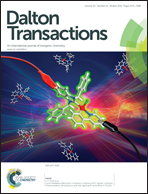DFT studies on the mechanism of alcohol oxidation by the (bpy)CuI-TEMPO/NMI catalytic system†
Abstract
Density functional theory (DFT) calculations have been performed to investigate the oxidation of alcohol to acetaldehyde, catalyzed by the (bpy)CuI-TEMPO/NMI catalytic system. Three pathways (path A, path B and path C) are presented. Our calculations indicate that path B is the favourable pathway. In path B, the alcohol coordinating to the CuI center provides a H atom to TEMPO to form TEMPOH. Another TEMPO then replaces TEMPOH to abstract the H atom from the Cα–H of the alcoholate (RCH2O−) to generate the aldehyde product. On the basis of the studied pathway, a possible mechanism is presented to explain the experimental observations.


 Please wait while we load your content...
Please wait while we load your content...